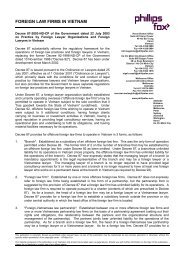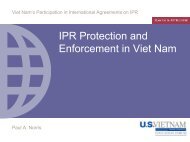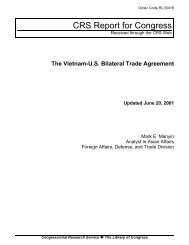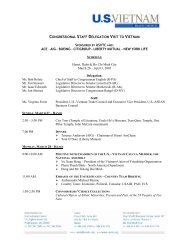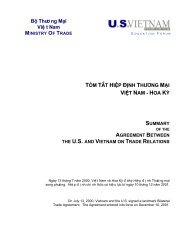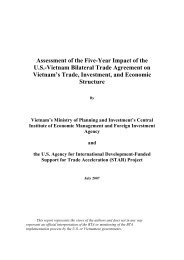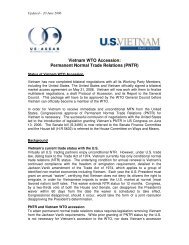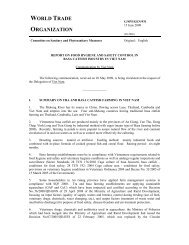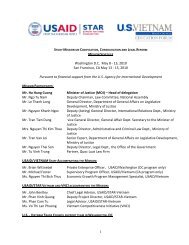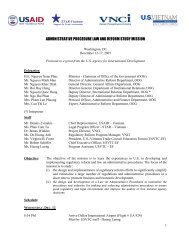Climate risks and adaptation in Asian coastal megacities: A synthesis
Climate risks and adaptation in Asian coastal megacities: A synthesis
Climate risks and adaptation in Asian coastal megacities: A synthesis
- No tags were found...
You also want an ePaper? Increase the reach of your titles
YUMPU automatically turns print PDFs into web optimized ePapers that Google loves.
Box 4.3 ■ Increased Time Costs <strong>and</strong> Health Risk from Flood<strong>in</strong>g <strong>in</strong> ManilaThe Manila study aggregates two different estimates to establish the cost of flood<strong>in</strong>g on road networks. It estimates the cost of ma<strong>in</strong>tenance onflood-affected roads <strong>and</strong> adds to this the cost of delays to private <strong>in</strong>dividuals that would result from flood<strong>in</strong>g. The cost of delays <strong>in</strong> travel because offloods are categorized <strong>in</strong>to vehicle operat<strong>in</strong>g costs <strong>and</strong> time costs. Vehicle operat<strong>in</strong>g costs are estimated by exam<strong>in</strong><strong>in</strong>g the <strong>in</strong>creased operat<strong>in</strong>g costsas a result of flood<strong>in</strong>g for public <strong>and</strong> private vehicles. For time costs, the Manila study relies on a survey of travelers <strong>and</strong> uses the average value of timeto evaluate private <strong>in</strong>dividuals time costs—separate costs are obta<strong>in</strong>ed for <strong>in</strong>dividuals us<strong>in</strong>g private <strong>and</strong> public transportation.The Manila study assesses the <strong>in</strong>crease <strong>in</strong> likely gastro<strong>in</strong>test<strong>in</strong>al diseases as a result of water <strong>in</strong>gestion <strong>and</strong> exposure to pathogens <strong>in</strong> flood water.Based on coefficients from a dose-response model <strong>and</strong> the average number of floods that occur per year, the study estimates the <strong>in</strong>crease <strong>in</strong> the annualrisk <strong>in</strong> gastro<strong>in</strong>test<strong>in</strong>al diseases <strong>in</strong> the areas that are likely to be flooded. The risk of gastro<strong>in</strong>test<strong>in</strong>al diseases from accidental <strong>in</strong>gestion of water rosefrom 0.0134 at <strong>in</strong>undation levels of 50 cm of flood waters to 0.187 for <strong>in</strong>undation levels above 200 cm of flood water. This analysis, while undertaken,was not directly used <strong>in</strong> the damage cost assessment.Source: Muto et al. (2010).Floods of different <strong>in</strong>tensity can costbetween 3 percent <strong>and</strong> 24 percent of GDPFigure 4.8 ■ Flood Costs as a Percentof 2008 GDPTable 4.10 compares a “without climate change”(SQ EX) <strong>and</strong> “with climate change” (A1FI-EX) scenario,<strong>in</strong>dicat<strong>in</strong>g that the costs of flood<strong>in</strong>g can rangefrom PHP 15 billion ($337 million) (SQ-EX-10) toPHP 111 billion ($2.5 billion) (A1FI-EX-100). S<strong>in</strong>cethese numbers are presented <strong>in</strong> 2008 values, we cancompare them to Metro Manila’s regional GDP of468 billion PHP (National Statistical Coord<strong>in</strong>ationBoard). Damage costs range from 3 percent of GDP(SQ-EX-10) to 24 percent (A1FI-EX-100).The costs of climate change range from PHP 4billion ($89 million) (1/10 flood) to 47 billion PHP60,000,000,00050,000,000,00040,000,000,00030,000,000,00020,000,000,00010,000,000,0000P30SQ EXP30SQ MPP30B1 EXSource: Based on estimations <strong>in</strong> Muto et al. (2010).P30B1 MPDamages to Build<strong>in</strong>gsP30A1FI EXP30A1FI MPTable 4.10 ■ Damage Costs from 1-<strong>in</strong>-10, 1-<strong>in</strong>-30, <strong>and</strong> 1-<strong>in</strong>-100-year Floods <strong>in</strong> DifferentScenarios (2008 PHP)FloodIntensity SQ EX A1FI-EX<strong>Climate</strong> ChangeDamage Costs(2008 PHP) withan A1FI Scenariowith EX1/10 15,276,335,523 19,388,093,046 4,111,757,522.591/30 40,164,225,177 68,964,812,770 28,800,587,593.151/100 64,727,999,688 111,892,101,862 47,164,102,174.61Source: Muto et al. (2010).(approximately $ 1 billion) (1/100 flood). As Figure4.8 shows, climate change costs represent 1 percent(1-<strong>in</strong>-10 flood), 6 percent (1-<strong>in</strong>-30 flood) <strong>and</strong> 10 percent(1-<strong>in</strong>-100 flood) of GDP.Prioritization of AdaptationOptions <strong>in</strong> ManilaThe Manila case study looked at a variety of <strong>adaptation</strong>options that could reduce the impact of 1-<strong>in</strong>-30<strong>and</strong> 1-<strong>in</strong>-100-year floods. The adaption options exam<strong>in</strong>ed<strong>in</strong>cluded improv<strong>in</strong>g current practices, capacitybuild<strong>in</strong>g <strong>and</strong> better coord<strong>in</strong>ation among local government<strong>and</strong> national flood management agencies<strong>and</strong> structural measures such as dam construction,Assess<strong>in</strong>g Damage Costs <strong>and</strong> Prioritiz<strong>in</strong>g Adaptation Options | 65



